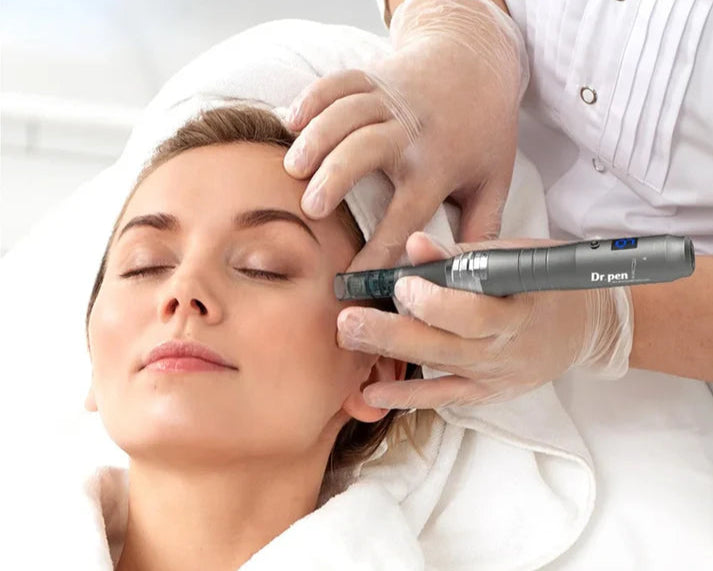In the quest for lush, vibrant hair, individuals have explored a myriad of solutions, ranging from topical treatments to invasive surgeries. Among the plethora of options, one particular method has garnered considerable attention in recent years: microneedling. Specifically, the use of a microneedling pen for hair restoration has sparked curiosity and hope among those seeking to combat hair loss. But does this technique truly hold promise, or is it just another fleeting trend in the vast landscape of hair regrowth solutions?

To delve into the potential of microneedling pens in hair restoration, it's essential to first understand the science behind hair loss. The most common form of hair loss, androgenetic alopecia, or male/female pattern baldness, is primarily driven by genetic factors and hormonal changes. In this condition, the hair follicles gradually shrink, producing finer and shorter hairs until they eventually stop growing altogether. Other contributors to hair loss include stress, poor diet, medical conditions, and certain medications.
Traditional treatments for hair loss often revolve around medications like minoxidil and finasteride, which have shown varying degrees of success. However, these treatments come with potential side effects and may not be suitable for everyone. Surgical options, such as hair transplants, while effective, are invasive and carry their own set of risks and recovery challenges. This has led to a growing interest in non-surgical, minimally invasive alternatives, one of which is microneedling.
Microneedling, also known as collagen induction therapy, involves the use of a device equipped with fine needles that puncture the skin at controlled depths. When applied to the scalp, this process is believed to stimulate the body's natural healing response. The tiny punctures created by the microneedling pen trigger a cascade of biological events, including the release of growth factors and cytokines. These signaling molecules play a crucial role in tissue repair and regeneration, potentially promoting hair follicle activity.
One of the key mechanisms by which microneedling may aid in hair restoration is through the stimulation of blood flow to the scalp. Improved circulation delivers essential nutrients and oxygen to the hair follicles, which are vital for their health and growth. Additionally, microneedling is thought to promote the production of collagen and elastin, structural proteins that contribute to the strength and elasticity of the skin and, by extension, the hair follicle environment.
Moreover, microneedling creates microchannels in the skin, which can enhance the absorption of topical hair loss treatments. By increasing the permeability of the scalp, the active ingredients in products like minoxidil or natural hair growth serums can penetrate deeper into the skin, potentially improving their effectiveness. This synergistic approach allows individuals to maximize the benefits of both microneedling and topical treatments.
Several studies have investigated the efficacy of microneedling for hair restoration, with promising results. In a 2013 study published in the International Journal of Trichology, researchers found that microneedling combined with minoxidil led to significant improvements in hair density and thickness compared to minoxidil alone. Participants who underwent microneedling experienced faster and more pronounced hair regrowth, suggesting that the technique could enhance the effectiveness of conventional treatments.
Another study, conducted in 2018 and published in the Journal of Cutaneous and Aesthetic Surgery, examined the use of microneedling in combination with platelet-rich plasma (PRP) therapy for androgenetic alopecia. The results showed that this combination therapy was effective in improving hair growth and density, further supporting the potential of microneedling as an adjunct therapy in hair restoration.
While the research is encouraging, it's important to note that microneedling is not a magic bullet for hair loss. The effectiveness of the treatment can vary from person to person, and multiple sessions may be required to see noticeable results. Furthermore, the procedure must be performed correctly to avoid complications such as infection, scarring, or damage to the hair follicles.
When considering microneedling for hair restoration, it's crucial to seek the services of a qualified professional. A trained practitioner will use a sterile microneedling pen with the appropriate needle length and density for the scalp. They will also ensure that the procedure is tailored to the individual's specific needs and hair loss pattern.
In addition to professional treatments, some individuals may opt for at-home microneedling devices. While these can be more convenient and cost-effective, they come with a higher risk of improper use and potential complications. It's essential to follow the manufacturer's instructions carefully and to avoid over-stimulating the scalp, which could lead to inflammation or injury.
To enhance the outcomes of microneedling for hair restoration, individuals can adopt a holistic approach that includes a balanced diet rich in vitamins and minerals, regular exercise to promote blood circulation, and stress management techniques. Incorporating scalp massages and using gentle, nourishing hair care products can also support the health of the hair follicles.
In conclusion, microneedling pens show promise as a non-surgical, minimally invasive option for hair restoration. By stimulating blood flow, promoting the production of collagen and elastin, and enhancing the absorption of topical treatments, microneedling may help to rejuvenate hair follicles and promote hair regrowth. While the research is still evolving, the existing evidence suggests that microneedling can be an effective adjunct therapy when used in conjunction with other hair loss treatments. As with any medical procedure, it's essential to consult with a qualified professional and to manage expectations realistically. With patience, consistency, and a comprehensive approach to hair health, microneedling may offer a viable path to a fuller, healthier head of hair.

Share:
What to Expect During a Microneedling Pen Session
The Best Microneedling Pen for Sensitive Skin